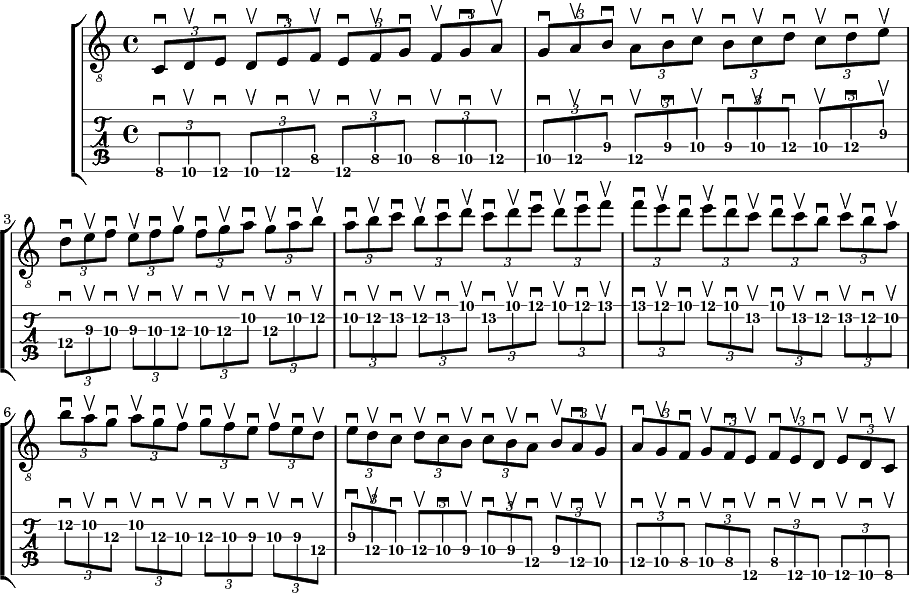Modes of the Major Scale
They just start on a different note!
When playing the modes of the major scale, it is played a bit differently than the conventional five patterns of the major scale. You always play three notes per string, this is why this scales are often called three-notes-per-string scales. If you've already played the major scale exercise (with the five patterns) you will notice that the last pattern is in fact the first mode of the major scale - the ionian mode.
The modal system works kinda like this - the regular major scale has half steps between the 3rd and 4th step and the 7th and 8th step (regardless of the tonic note!). If you start the major scale from any other note that its tonic note (the 1st note) the positions of the half steps shift and you get a new scale.
If you start the C major scale from the D, the half steps are now shifted to 2nd and 3rd step, and 6th and 7th step. The result is the D dorian scale. If you start playing the C major scale from any other of the remaining notes (E, F, G, A, and B) you get the following scales: E phrygian, F lydian, G mixolydian, A aeolian, and B locrian.
Here are the patterns for all seven modes of the C major scale:
C - Ionian
The ionian mode of the major scale is the well known and loved C Major scale that goes like this: C D E F G A B C. Check it out in this fretboard diagram:
D - Dorian
You get the dorian mode if you just start the C major scale from the D. The scale then goes like this: D E F G A B C D.
E - Phrygian
Shift that scale again for one whole note and you get: E F G A B C D E. The Phryigian mode!
F - Lydian
The Lydian mode is the fourth mode of the major scale, which means the scale is shifted for four tones. It goes like this: F G A B C D E F.
G - Mixolydian
When you shift the scale for five notes you get the Mixolydian mode. If the scale is C major, the fifth mode is in G and it goes like: G A B C D E F G
A - Aeolian
The Aeolian mode of the C major scale is in fact the A minor scale. It's the sixth mode and it is good to remember that you can transform any major scale to a minor scale by just shifting it for 6 tones. For example, you can get the E minor scale if you start playing the G major scale form the E (which is 6 tones apart from the G).
B - Locrian
The seventh mode is the Locrian mode. It starts with the B and goes like this: B C D E F G A B.
Seven modes from a single tonic note
It works the other way round as well. You can start with the single tonic note and play all the modes (just start all the above patterns on the same fret) - let's say the 8th fret, the C. Take a gander at what happens:
| mode | 1 | 2 | 3 | 4 | 5 | 6 | 7 | 8 | actual key |
|---|---|---|---|---|---|---|---|---|---|
| C-ionian | C | D | E | F | G | A | B | C | C-major |
| C-dorian | C | D | Eb | F | G | A | Bb | C | Bb-major |
| C-phrygian | C | Db | Eb | F | G | Ab | Bb | C | Ab-major |
| C-lydian | C | D | E | F# | G | A | B | C | G-major |
| C-mixolydian | C | D | E | F | G | A | Bb | C | F-major |
| C-aeolian | C | D | Eb | F | G | Ab | Bb | C | Eb-major (or C minor) |
| C-locrian | C | Db | Eb | F | Gb | Ab | Bb | C | Db-major |
When you play different modes from the same tonic note the key changes.
C - ionian, groups of 3
In this exercise you will learn and play the C ionian scale in groups of three succsessive notes. Your right hand will be alternately picking up and down each note (watch out when changing strings, be consistent).
Check out the diagram and the tabs to get you started. Once you get the pattern down, you should not look at it anymore.
